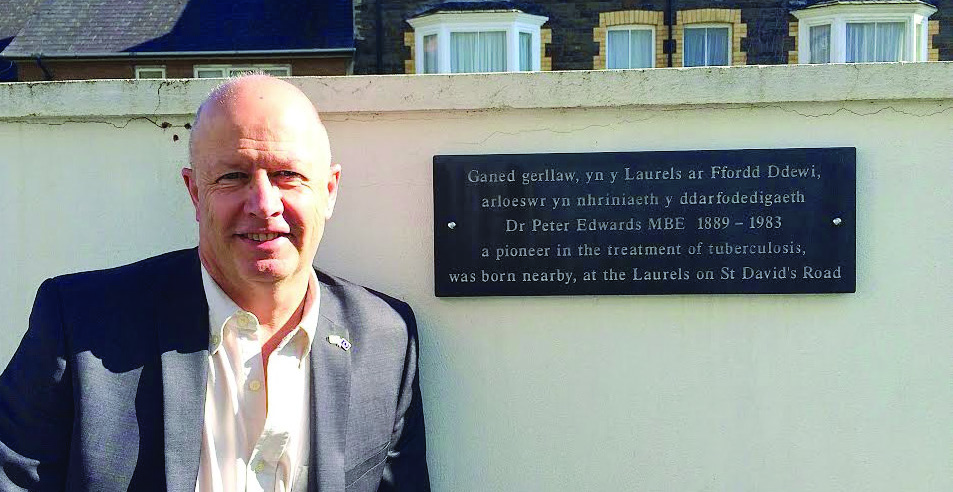 THE MAYOR, Dr Endaf Edwards, has performed his last official duty unveiling a commemorative plaque to Dr Peter Edwards.
THE MAYOR, Dr Endaf Edwards, has performed his last official duty unveiling a commemorative plaque to Dr Peter Edwards.
Dr Endaf Edwards now hands over office to the new mayor Brendan Somers, for many years a popular landlord at Y Cwps (The Coopers Arms) on Northgate Road in Aberystwyth.
Dr Peter Edwards MBE was born just around the corner from Bronglais Hospital. He went on to have a distinguishe d career specialising in the treatment of Tuberculosis (TB). A bacterial infection spread by inhaling tiny droplets from the coughs or sneezes of an infected person, TB mainly affects the lungs. It can also develop in any part of the body, however, including in glands, bones and nervous system.
A former TB sufferer himself, Dr Peter Edwards adopted ground-breaking approaches to the treatment of this serious disease before the emergence of anti-biotics. He was also highly regarded for his egalitarian approach to his staff and patients.
Councillor Alun Williams said: ‘It is very appropriate that Dr Peter Edwards should be honoured with a plaque in the same corner of Aberystwyth where he was brought up. I’d particularly like to thank George Simpson, an Aberystwyth resident, who was under his care at the Joint Cheshire Sanatorium in Staffordshire.
Thanks to George for bringing the life and good works of Dr Edwards to everyone’s attention.’ George Simpson’s admiration for Dr Edwards featured in a story in the Aberystwyth EGO back in May 2015.
BEFORE PENICILLIN
Before the discovery of penicillin, TB was a life threatening disease in the UK. Catching TB meant a patient would likely be sent away to a specialist sanatorium for a very long stay, sometimes stretching to years. Given the highly infectious nature of TB, patients had no choice about being sent away and isolated, often far from their homes and families.
In West Wales, TB persisted long after it had been eliminated in the rest of Wales. Its tenacity is partly explained by the reluctance of some health boards to sign up for the King Edward VII Fund, which fought against TB, due to the fear of losing local autonomy for the delivery of health services. In Pembrokeshire, in particular, TB remained a threat into the 1950’s.
Through the 1930s and 40s thousands of patients were sent to the Joint Cheshire Sanatorium in Loggerheads, Staffordshire. Dr Peter Edwards was the man in charge of this 300 bed sanatorium. Dr Edwards’ prescription was plenty of rest and plenty of fresh air.
Even when it snowed the patients’ beds would daily be wheeled outside and neatly lined up. Sandbags placed across patients’ chests were thought to challenge their lungs to work hard and recover. Dr Edwards had pine trees planted believing their scent would benefit his patients. If bracing air and a sandbag did not do the trick, Dr Edwards would consider surgery.
Although by today’s standards being a patient at the Joint Cheshire Sanatorium sounds like a nightmare, in its day the treatment was medically innovative. Many patients were indeed helped and important discoveries made along the way. Moreover, the standard of care was very high and the sanatorium had sporting facilities and even its own cinema.
When the sanatorium began to use penicillin in the form of streptomycin it proved a much more effective treatment for TB, though Dr Edwards did not completely abandon his prescription of fresh air. The sanatorium closed in 1969 and Dr Peter Edwards died in retirement in 1983.
TB IN BRITAIN TODAY
Despite widespread access to antibiotics, TB has not been eradicated in modern Britain.
In 2014, TB Alert recorded 6,520 cases of the disease in the UK. In some boroughs of London the rate of infection is higher than in parts of Rwanda, Iraq or Eritrea. Food poverty, cuts in health and social services, rising poverty and homelessness all create gateways for the disease.
Worldwide, TB remains one of the biggest killer diseases. The World Health Organisation estimate the disease caused 1.5 million deaths in 2014, making it a greater threat to life than HIV/AIDs. According to the Centre for the Disease Control and Prevention, one-third of the world’s population carries the disease in its latent form with around 10% developing the illness. So, TB is not an illness confined to Victorian times or the pre antibiotic days of Dr Edwards.
In fact, the threat of TB could be exacerbated by the over-prescription and misuse of antibiotics, not only in human beings but in animals which are in the human food chain.
With the emergence of drug resistant forms of TB, medical research is still needed today.
















Add Comment